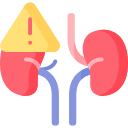THIORIDAZINE
THERAPEUTICS
Class
- Neuroscience-based Nomenclature: dopamine, serotonin receptor antagonist (DS-RAn)
- Conventional antipsychotic (neuroleptic, phenothiazine, dopamine 2 antagonist)
THIORIDAZINE commonly prescribed for
(Bold for FDA approved)
 How THIORIDAZINE works
How THIORIDAZINE works
• Blocks dopamine 2 receptors, reducing positive symptoms of psychosis
How long until THIORIDAZINE works
• Psychotic symptoms can improve within 1 week, but it may take several weeks for full effect on behavior
SIDE EFFECTS
 Notable Side Effects
Notable Side Effects
• Neuroleptic-induced deficit syndrome
• Akathisia
• Priapism
• Drug-induced parkinsonism
• Tardive dyskinesia
• Risk of potentially irreversible involuntary dyskinetic movements may increase with cumulative dose and treatment duration
• Galactorrhea, amenorrhea
• Pigmentary retinopathy at high doses
• Dizziness, sedation
• Dry mouth, constipation, blurred vision
• Decreased sweating
• Sexual dysfunction
• Hypotension
• Weight gain
 Life Threatening Side Effects
Life Threatening Side Effects
• Rare neuroleptic malignant syndrome may cause hyperpyrexia, muscle rigidity, delirium, and autonomic instability with elevated creatine phosphokinase, myoglobinuria (rhabdomyolysis), and acute renal failure
• Rare jaundice, agranulocytosis
• Rare seizures
• Dose-dependent QTc prolongation
• Ventricular arrhythmias and sudden death
• As a class, antipsychotics are associated with an increased risk of death and cerebrovascular events in elderly patients with dementia; not approved for treatment of dementia-related psychosis
weight gain

common
sedation

common
What to do about THIORIDAZINE side effects
• Wait
• Wait
• Wait
• For drug-induced parkinsonism, add an anticholinergic agent
• Reduce the dose
• For sedation, give at night
• Switch to an atypical antipsychotic
• Weight loss, exercise programs, and medical management for high BMIs, diabetes, dyslipidemia
DOSING AND USE
usual dosage range
• 200–800 mg/day in divided doses
 Dosage Forms
Dosage Forms
• Tablet 10 mg, 15 mg, 25 mg, 50 mg, 100 mg
• Liquid 30 mg/mL, 100 mg/mL (discontinued in USA)
• Suspension 5 mg/mL, 20 mg/mL (discontinued in USA)
long term use
• Should periodically reevaluate long-term usefulness in individual patients, but treatment may need to continue for many years
habit forming
• No
SPECIAL POPULATIONS
 Renal Impairment
Renal Impairment
• Use with caution
 Hepatic Impairment
Hepatic Impairment
• Use with caution
 Cardiac Impairment
Cardiac Impairment
• Thioridazine produces a dose-dependent prolongation of QTc interval, which may be enhanced by the existence of bradycardia, hypokalemia, congenital or acquired long QTc interval, which should be evaluated prior to administering thioridazine
• Use with caution if treating concomitantly with a medication likely to produce prolonged bradycardia, hypokalemia slowing of intracardiac conduction, or prolongation of the QTc interval
• Avoid thioridazine in patients with a known history of QTc prolongation, recent acute myocardial infarction, and uncompensated heart failure
• Risk/benefit ratio may not justify use in cardiac impairment
 Elderly
Elderly
• Some patients may tolerate lower doses better
• Elderly patients may be more sensitive to adverse effects, including agranulocytosis and leukopenia
• Although conventional antipsychotics are commonly used for behavioral disturbances in dementia, no agent has been approved for treatment of elderly patients with behavioral symptoms of dementia such as agitation
• Elderly patients with dementia-related psychosis treated with antipsychotics are at an increased risk of death compared to placebo, and also have an increased risk of cerebrovascular events
 Children and Adolescents
Children and Adolescents
• Safety and efficacy not established in children under age 2
• Dose: initial 0.5 mg/kg per day in divided doses; increase gradually; maximum 3 mg/ kg per day
• Risk/benefit ratio may not justify use in children or adolescents
 Pregnancy
Pregnancy
• Effective June 30, 2015, the FDA requires changes to the content and format of pregnancy and lactation information in prescription drug labels, including the elimination of the pregnancy letter categories; the Pregnancy and Lactation Labeling Rule (PLLR or final rule) applies only to prescription drugs and will be phased in gradually for drugs approved on or after June 30, 2001
• Controlled studies have not been conducted in pregnant women
• There is a risk of abnormal muscle movements and withdrawal symptoms in newborns whose mothers took an antipsychotic during the third trimester; symptoms may include agitation, abnormally increased or decreased muscle tone, tremor, sleepiness, severe difficulty breathing, and difficulty feeding
• Reports of drug-induced parkinsonism, jaundice, hyperreflexia, hyporeflexia in infants whose mothers took a phenothiazine during pregnancy
• Psychotic symptoms may worsen during pregnancy and some form of treatment may be necessary
• Atypical antipsychotic may be preferable to conventional antipsychotics or anticonvulsant mood stabilizers if treatment is required during pregnancy
• Should evaluate for an antipsychotic with a better risk/benefit ratio if treatment is required during pregnancy
 Breast Feeding
Breast Feeding
• Unknown if thioridazine is secreted in human breast milk, but all psychotropics are assumed to be secreted in breast milk
• Recommended either to discontinue drug or bottle feed
Based on data Published online by Cambridge University Press
Compiled by Dr. Jash Ajmera